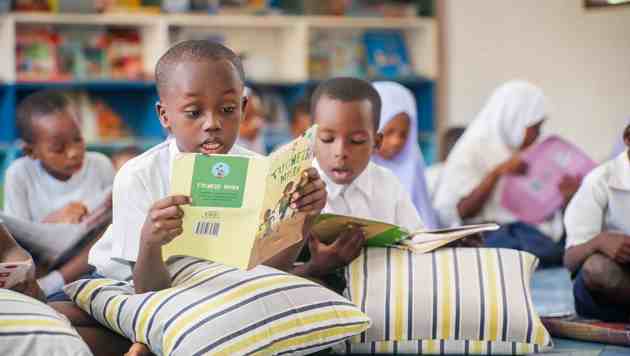There's a long, broad desk on the front porch of Pratik's family's house. Colorful books hang in orderly rows on the wall above the desk, just an arm’s reach away. Pratik's notebooks and worksheets are stacked neatly below them, next to a radio — through which he listens to Room to Read literacy programming — a calculator and a few pens. This is Pratik's home library, a space devoted to learning and imagination, a space of comfort and curiosity where Pratik, a 9-year-old student from Nepal, can focus on his studies outside of the classroom. Families around the world began creating home libraries like Pratik’s amid the sweeping school closures that followed the onset of the COVID-19 pandemic, and these child-friendly reading and study nooks continue to be immensely valuable spaces for young learners, even as schools reopen.
Like many children in his community, Pratik found it extremely difficult to continue his education during pandemic-related lockdowns and school closures. Because he is a first-generation student, members of his family were often unable to help him with his schoolwork. And, because the home lacked internet access and other technology needed for most remote instruction, Pratik was unable to attend online classes, leaving him on his own to navigate a complex and confusing educational landscape.
"Pratik enjoys reading, especially reading stories to us, but we were unable to assist him during the long school closure when he encountered difficulties with his reading sessions. We also had limited ideas on how to use his books or what tactics to use at home to keep him studying," Pratik's mother said.

For many children in communities across Nepal, online learning is difficult, often impossible. The pandemic caused major learning disruptions — reliable internet access is rare in rural communities, and many caregivers struggled to use smartphones and computers. These challenges affected over a year of learning for children. Like many parents and caregivers, Pratik's parents were concerned about their son’s potential learning loss. In response to what was quickly revealing itself to be an educational crisis for millions of children like Pratik, Room to Read began adapting our programming to benefit children across our partner communities who lacked reliable access to technology, prioritizing the dissemination of hard copy learning materials.
Throughout December 2021, Room to Read staff distributed home learning packages while schools remained closed. More than 6,000 children in Room to Read Nepal's program districts received a home learning package that contained worksheets with guided teaching, stationery, children's storybooks and coloring books, all designed to assist children and caregivers in learning at home. Room to Read also provided parents and caregivers with orientation sessions via phone on how to use the worksheets, how to create child-friendly learning environments and how to create an effective study schedule. Many children, Pratik among them, were eager to find a suitable location in their homes to set up their own reading and studying area.

Dedicated home learning spaces provide a myriad of benefits for young learners. These spaces can spark a student’s creativity, enhance their focus and increase their motivation. Pratik’s space accomplishes a number of important goals — it includes a clean surface with a comfortable, sturdy chair in a space with strong lighting, suitable for extended periods of reading and writing. His reading and academic books are hung above his desk for easy access. Displaying books in this way also adds warmth and color to Pratik’s learning space, which cultivates feelings of comfort and coziness and helps to stimulate curiosity.
Twenty of the 26 families from Pratik’s school have set up home study areas for their children, where young learners can explore storybooks at home and enjoy the many benefits of a dedicated learning space. Providing students with these inviting spaces helps children develop a love of reading, while building their foundational literacy skills. And when children develop a love of reading, that love often grows beyond the walls of libraries to become a lifelong habit.



